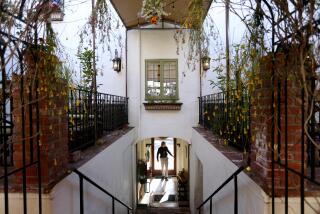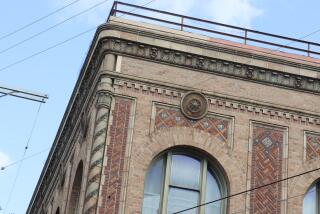Propping Up the Past
- Share via
PIRU — In its 1950s heyday, the joint was hopping: weddings, baptisms, quinceaneras and dancing to the golden tones of local bands.
Today the Quonset hut, with its broken windows, dirty metal siding and chipped linoleum floors is a sagging afterthought in the corner of Warring Park. Tucked behind pepper trees, it was displaced as the tiny community’s social hub by the shinier Piru Community Center built 10 years ago.
County officials have talked about tearing down the relic, leading a handful of Piru residents--many of them third- or fourth-generation--to lobby for the cream-colored hut’s preservation as a historical site.
It may not be the Taj Mahal--it may not even be a real building--said one activist, but it’s a part of the town’s history, and many of its 1,800 residents want it saved.
Their campaign suffered a setback last week with the death of Al Gaitan, a 58-year-old lifelong Piru man who had spent much of the last year working on getting historical landmark status for the hut. He died of complications from diabetes.
Gaitan’s supporters say his passing has only made them more determined to see his wish achieved.
“Al always said people need to know the real Piru,” said Stephanie Acosta, 34, a youth coordinator who has taken up the cause. “Everybody bypasses us like we don’t exist.”
After the 1994 Northridge earthquake damaged many of this unincorporated town’s older buildings, county redevelopment money poured in. Since then, the sight of construction crews replacing the old with the new has been commonplace.
More such work is planned, including extending a tourist railroad line through Piru and a town square project including a train depot, gazebo and fountain, which will cost more than $1 million.
Tourist money would be welcome in the economically strapped town, but seeing more and more of their history disappear in the name of progress has made some residents realize they’ve taken their past for granted.
“The old folks are all gone; there’s nothing here anymore,” said Rita Miranda, 62, of Santa Barbara, who grew up in Piru and came to town Tuesday for the funeral of Gaitan, her brother.
Gaitan, known as “Big Al” or “Poncho” around town, contacted county officials when he learned the old hut would be moved or torn down to make way for the railroad.
Monica Nolan, Piru’s economic development coordinator, said the county’s Cultural Heritage Board might agree to grant landmark status if residents really want it. But it may take some convincing. Since the new community center was built in 1990, few people have rented the Quonset hut, which for years was the only community center in town.
Rental rates are the same for both buildings, so people tend to choose the newer building over the hut, which was last used as a Boy Scouts and youth clubhouse.
“If there is really a sentiment in the community to save it, the community’s got to decide,” Nolan said. “Otherwise, I can see the rationale for the [county] wanting to take it down.”
There’s also the historical aspect, she said. She told Gaitan that if he could document the hut’s cultural importance to the city, there might be a case to save it.
Gaitan’s quest to do so made many in town realize how little they’ve done to preserve their past. Everyone remembers good times in the hut, but few have specifics: photographs, baptism certificates, even an exact date of when it was built.
Some town natives think it was erected between 1945 and 1950 and was initially used to house migrant workers from Mexico. Harry Lechler, a lifelong resident and acknowledged keeper of the town’s history, thinks it was built during World War II, but isn’t sure.
The hut is not likely to receive any county redevelopment money if it is designated a landmark, Nolan said, because those funds are targeted for modernization projects. But Acosta said landmark status could bring in grant money to help maintain the property.
Acosta said that although Gaitan did not succeed in saving the hut before he died, he may have left a greater legacy by creating a town of amateur historians.
“If we can save the hut, or at least move it, then that will be something important for the younger generation,” Acosta said.
More to Read
Sign up for Essential California
The most important California stories and recommendations in your inbox every morning.
You may occasionally receive promotional content from the Los Angeles Times.










